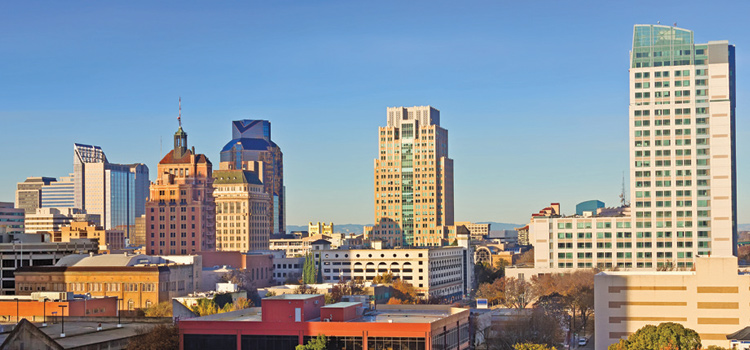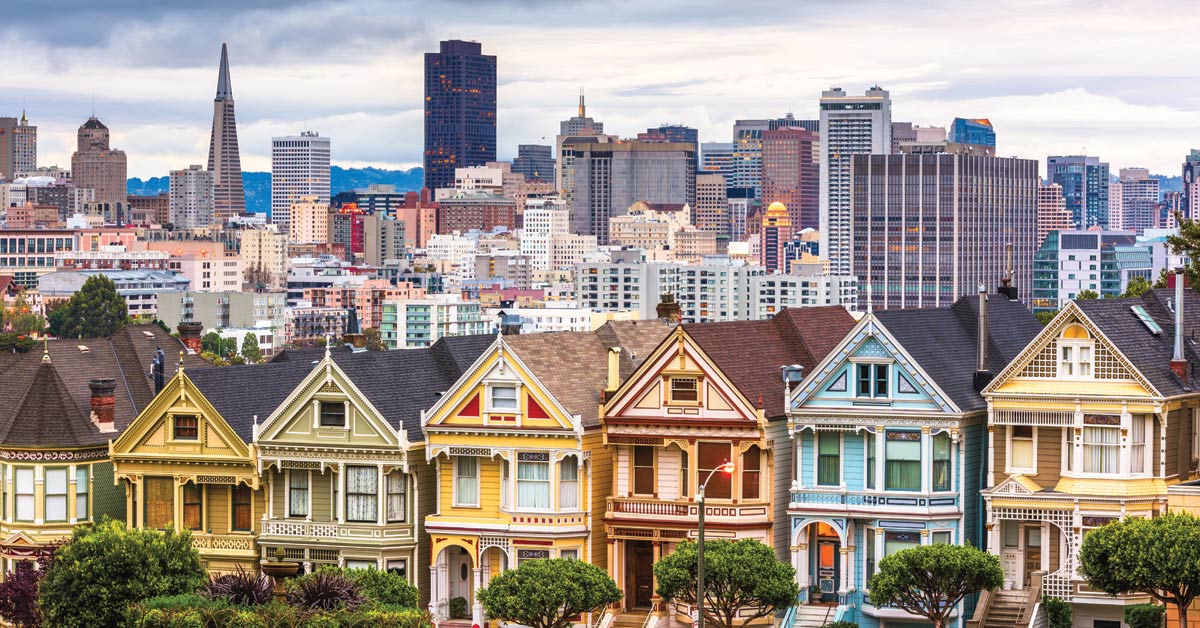Bill Hewlett and Dave Packard met in the early 1930s as Stanford University engineering students, bonded during a two-week camping trip and formed one of the most successful companies in U.S. history. They flipped a coin to decide whose name would go first.
Hewlett-Packard became a global leader in electronics, so synonymous with innovation that the single-car garage in Palo Alto, California, where the pair started is dubbed the birthplace of Silicon Valley. Last year, however, an offshoot of this iconic company bailed on the Golden State. Hewlett Packard Enterprise (HPE) — the smaller of two companies that formed after the original split apart in 2015 — announced plans to move its global headquarters to Houston. It was just one of a number of high-profile departures from California in 2020.
HPE, software giants Oracle and Palantir, and even billionaire innovator Elon Musk decided to head east to Texas. The Hoover Institution points out that thousands of businesses, including 765 commercial facilities in 2018 and 2019 alone, have left the Golden State over the past 15 years to seek better business environments and lower land costs.
Still, California remains the nation’s largest state economy, generating $3 trillion in economic output in 2019. By comparison, second-place Texas had an economic output of $1.9 trillion. Fifty-three Fortune 500 companies are headquartered in California, second only to New York.
California’s population continued to grow in 2020, with an additional 21,200 residents from July 2019 to July 2020 bumping its total to 39.8 million. Population growth has slowed over the past three years, similar to trends that occurred in the 1990s when the end of the Cold War hurt the aerospace and defense industries, and again in the 2000s prior to the Great Recession.
Although the Golden State has weathered businesses pulling up stakes and moving elsewhere, the coronavirus outbreak is something else. California’s economy has struggled considerably throughout the pandemic. The state’s unemployment rate spiked to an all-time high of 16.4% in April and May of last year. The rate declined to 8.2% by November 2020, but was still much higher than the U.S. rate of 6.7% at that time.
The state government saw a projected budget surplus of $5.6 billion at the start of 2020 turn into a $54 billion deficit. Gov. Gavin Newsom warned that this could mean furloughs for thousands of state workers, and reduced funding for courts, universities and K-12 schools. UCLA economists predicted late last year that California’s recovery will lag behind the nation as a whole, in part because the state is so dependent upon tourism and retail, two of the hardest-hit employment sectors during the pandemic. ●
 One of the bright spots of the California economy is the housing sector. In November 2020, annualized sales of existing single-family homes surpassed 500,000 for the first time in 11 years, according to the California Association of Realtors. Median home prices in the Golden State went above $700,000 this past September before dipping to $699,000 in November.
One of the bright spots of the California economy is the housing sector. In November 2020, annualized sales of existing single-family homes surpassed 500,000 for the first time in 11 years, according to the California Association of Realtors. Median home prices in the Golden State went above $700,000 this past September before dipping to $699,000 in November.
Low interest rates and the flexibility to work from home were the main drivers for the surging interest in homebuying, according to the Realtor association. Statewide housing supply, however, continues to be a major hindrance. Remote-work trends accelerated by the pandemic could help the state’s housing crisis. Since the start of the COVID-19 outbreak, rents dropped in San Francisco, San Jose and Oakland while rising in less-expensive areas such as Sacramento, Fresno and Bakersfield, according to nonprofit journalism venture CalMatters.
Sacramento is expected to be the nation’s hottest housing market in 2021, according to Realtor.com. It has become an ideal destination for Bay Area office workers who can work from home much of the time, with a 90-minute commute to San Francisco.
Focus: Tourism
From the La Brea Tar Pits in the south to the redwood forests in the north, and from El Capitan in Yosemite National Park to Venice Beach in Los Angeles, California has some of the most popular tourist destinations in the world. The COVID-19 crisis has hit the Golden State’s tourism industry particularly hard.
Travel and tourism revenue fell from a 10-year high of $145 billion in 2019 to $66 billion in 2020, costing the state 613,000 tourism-industry jobs. At the end of 2020, Disneyland and the nearby California Adventure Park in Anaheim had been shut down until further notice.
International travel disappeared altogether during the pandemic and in-state travel was decimated by restrictions implemented by the state in response to spiking coronavirus cases. Once the restrictions are lifted, the San Diego Tourism Authority reportedly hopes to resume its “Happiness is Calling You Back” marketing campaign aimed at travelers within driving distance.
What the locals say
“I think there’s a big movement to single-family homes or houses with a little more space. I have never had more people who work at Google, work at Apple, work at Facebook (in the Bay Area) who are buying in places like Hollister, San Diego or up north in Twain Harte, towns that are just way out there. … I talk to a lot of people at Google and Apple, and ask their opinion, and I think that a lot of people want to be in an office. They’re missing out on the camaraderie at the office. They’re getting tired of the Zoom calls. I think that there will be a movement back into the office. How that looks, I don’t know.”

Brandon Knapp
Branch manager, RPM Mortgage
3 Cities to Watch
Los Angeles
 The City of Angels has struggled through the pandemic with residents suffering from a higher rate of economic insecurity than the nation as a whole, according to a University of Southern California study. L.A. also has a high concentration of freelancers, with more than 400,000 people employed in creative, professional and technical services, and the pandemic has hit these workers particularly hard. Los Angeles County has a population of 10.2 million and a dynamic mix of tech, aerospace, manufacturing and international-trade jobs.
The City of Angels has struggled through the pandemic with residents suffering from a higher rate of economic insecurity than the nation as a whole, according to a University of Southern California study. L.A. also has a high concentration of freelancers, with more than 400,000 people employed in creative, professional and technical services, and the pandemic has hit these workers particularly hard. Los Angeles County has a population of 10.2 million and a dynamic mix of tech, aerospace, manufacturing and international-trade jobs.
San Jose
 San Jose, with a population of nearly 1.1 million, already has tech giants Facebook, Apple and Google in its backyard, along with world-class research institution Stanford University churning out talented and entrepreneurial-minded graduates each year. City leaders are confident that downtown will flourish over the next decade despite the pandemic. Major ongoing projects include a new Google campus with 7.3 million square feet of office space and 4,000 housing units, and mega-developer Jay Paul’s three-tower, 3.8 million-square-foot downtown office park.
San Jose, with a population of nearly 1.1 million, already has tech giants Facebook, Apple and Google in its backyard, along with world-class research institution Stanford University churning out talented and entrepreneurial-minded graduates each year. City leaders are confident that downtown will flourish over the next decade despite the pandemic. Major ongoing projects include a new Google campus with 7.3 million square feet of office space and 4,000 housing units, and mega-developer Jay Paul’s three-tower, 3.8 million-square-foot downtown office park.
Sacramento
 It could take five years for Sacramento to recover from the economic fallout of the coronavirus pandemic. This past summer, the Greater Sacramento Economic Council advised small businesses that it may be better to close, at least temporarily, until the economy recovers. Sacramento County has the largest concentration of state employees with nearly 73,000 full-time workers. Budget hits could hurt the city in the coming months and years. Sacramento has a population of 510,000 and its median household income is $62,335.
It could take five years for Sacramento to recover from the economic fallout of the coronavirus pandemic. This past summer, the Greater Sacramento Economic Council advised small businesses that it may be better to close, at least temporarily, until the economy recovers. Sacramento County has the largest concentration of state employees with nearly 73,000 full-time workers. Budget hits could hurt the city in the coming months and years. Sacramento has a population of 510,000 and its median household income is $62,335.
Sources: American Enterprise Institute; Bloomberg; California Association of Realtors; California Department of Finance; California Employment Development Department; CalMatters; California State Controller’s Office; Fortune; Hoover Institution; Investopedia; KXTV; Los Angeles Magazine; National Public Radio; Realtor.com; San Jose Spotlight; The Associated Press; The Mercury News; U.S. Bureau of Labor Statistics; U.S. Census Bureau; Wired





